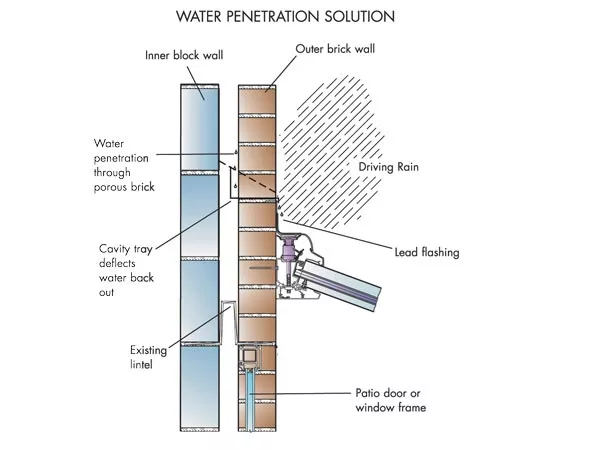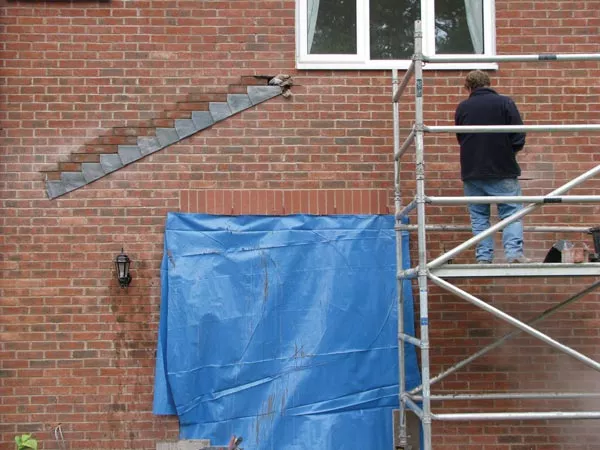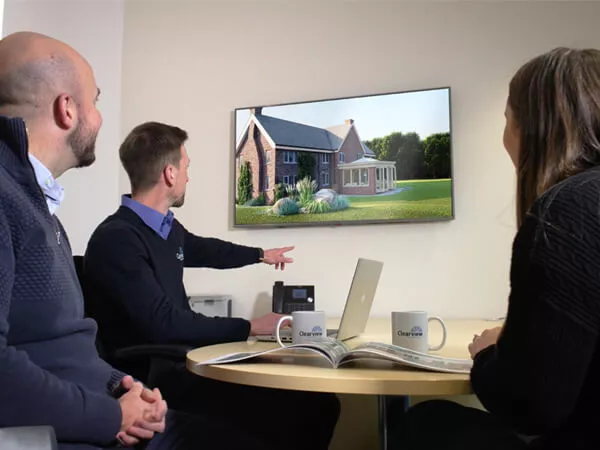What Is A Cavity Tray And Will My Conservatory Or Orangery Need One?
What is a Cavity Tray?
There is absolutely no shame in not knowing what a cavity tray is as most of our customers don’t. However, once you have begun discussing conservatories and orangeries with a Clearview consultant you will be fully up-to-speed with its purpose and importance.
A cavity tray is an internal moisture or water barrier featuring a series of trays designed to stop rainwater from falling into the cavity wall and causing damp above any windows and doors included in the design. Any damp is usually the result of heavy rainfall soaking the external brickwork and seeping into the cavity between the inner and outer walls. This is something that needs to be seriously thought about when a current external wall of a house is adapted into a rear internal wall due to the installation of a conservatory, orangery or solid roof extension.

Don’t forget about our forever unpredictable climate too!
As we’re constantly reminded, we live in one of the world’s rainiest countries. It’s not unusual for some parts of the region to experience a month’s worth of rain in a single day and it’s won’t get dryer in the long-term that’s for sure.
Increased rainfall over the past few years has necessitated the installation of a cavity tray retrospectively in many old extensions that previously went without one.
Erring on the side of caution is ultimately your best bet as a cavity tray will future-proof your conservatory or orangery against potential damp, so ask us to include it in the final costing up of your chosen design.

View Clearview’s living spaces
View our living spaces – the perfect taster of all the amazing choices of living space designs we have to offer. Browse at your leisure and any questions you have, simply get in touch online or call 0800 011 2400 for a chat with one of our friendly customer advisors.
A Clearview consultant would be happy to give you more information about cavity trays and our market-leading conservatory and orangery designs. Book an appointment for a 1-hour long discussion.
Request your free quote
Simply fill in your details for your free, no obligation quotation, and click “Get Quote”
Explore the top 10 common questions on cavity trays
Get further insights on the benefits of cavity trays for conservatories, and why Clearview would recommend a cavity tray for your living space if you suffer from extreme weather conditions in your area of Cheshire or Lancashire.
What is a cavity tray, and why is it necessary for conservatories?
A cavity tray is a component used in building construction to manage water penetration and prevent dampness. In conservatories, cavity trays are crucial at junctions where the conservatory meets the main building to prevent water ingress and potential structural damage.
Where exactly should cavity trays be installed in a conservatory?
Cavity trays should be installed at critical points where water ingress is likely, such as the base of the conservatory walls and junctions between the conservatory and the main building. Proper placement ensures effective water management and prevents dampness.
Are there different types of cavity trays available for conservatories?
Yes, there are various types of cavity trays designed specifically for conservatory installations, including horizontal, stepped, and vertical cavity trays. Each type serves a specific purpose in redirecting water away from vulnerable areas.
How do cavity trays prevent dampness and structural damage in conservatories?
Cavity trays act as a barrier against water penetration by intercepting and redirecting moisture away from vulnerable areas. By effectively managing water runoff, cavity trays help prevent dampness, mold growth, and potential structural deterioration caused by moisture exposure.
Do cavity trays require maintenance in conservatories?
Yes, cavity trays may require periodic maintenance to ensure their effectiveness. Inspections should be carried out regularly to check for any blockages or damage that could impede water drainage. Cleaning and clearing debris from the trays may also be necessary to maintain proper functionality.
Are cavity trays mandatory according to building regulations for conservatories?
Cavity trays are typically recommeded by building regulations for conservatories to comply with moisture management standards. Regulations may specify the type, placement, and installation requirements for cavity trays to prevent water ingress and protect the building structure.
Can cavity trays be retrofitted in existing conservatories?
Yes, cavity trays can often be retrofitted in existing conservatories to improve moisture management and prevent water ingress. However, the feasibility of retrofitting depends on various factors, including the construction of the existing conservatory and access to critical junctions.
Are there specific materials recommended for cavity trays in conservatories?
Cavity trays for conservatories are typically made from durable materials such as UPVC, metal, or lead. The choice of material depends on factors like durability, compatibility with other building materials, and local building regulations.
Do cavity trays affect the aesthetics of conservatories?
While cavity trays are primarily functional components, they can be designed to minimize visual impact on the aesthetics of conservatories. Some trays are designed to blend with surrounding materials or can be concealed within construction details to maintain the overall aesthetic appeal of the structure.
How can I ensure proper installation of cavity trays in my conservatory?
Proper installation of cavity trays is crucial for their effectiveness. It’s recommended to consult with building professionals or follow manufacturer guidelines for installation. Ensuring correct placement, sealing, and integration with other building components is essential.
What happens next?
In order to help us create your ideal proposal, we’ll have a chat and gather a few more details. How we meet is entirely up to you – we’re totally flexible to suit your lifestyle. Just let our team know which option you prefer when we contact you.

Showroom Visit
Not sure what you’re looking for? We have the perfect setting to get inspired! You’ll be able to see a huge choice of windows, doors and home extensions to really get a feel for what you like. One of our specialists will gladly show you around and work with you to design and price your home improvements.

Home Visit
If you’re comfortable with a home visit, one of our specialists will visit at a time to suit you. We will advise on designs, technical details and measurements, ensuring we can bring your ideas to life and provide you with an accurate quotation. We’ll only stay for as long as you like – a typical visit lasts around one hour.

Online Video Chat
Let’s face it, these days we all lead busy lifestyles and your time is precious. If you prefer, we can speak to you via video link at a time to suit you. Using our very latest design software, we can design and create your perfect living space with you on screen and give you an instant price from the comfort of your sofa.
Book your free appointment
Enjoy a free, no-obligation appointment in your home or in your local Clearview showroom to start your project. Simply fill your details below.
Want to speak with an advisor? Give us a call on 0800 011 2400
Our friendly team will be pleased to help with any questions you may have.
